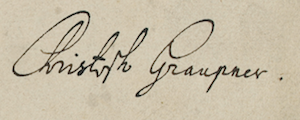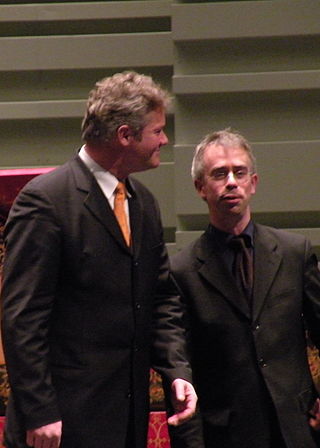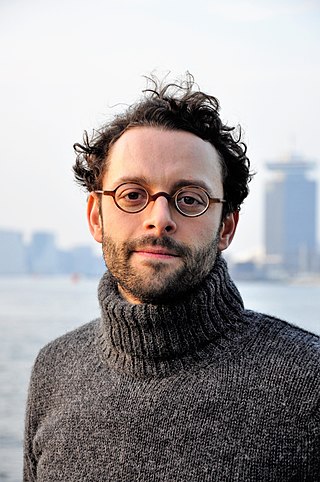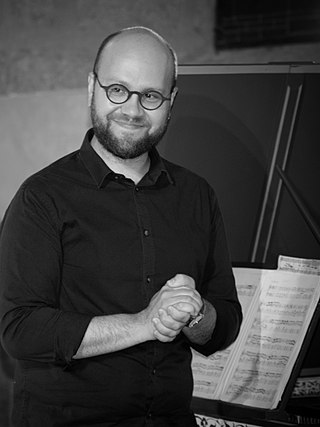
Fernando De Luca (born 1961 in Rome) is an Italian harpsichordist, organist, teacher and composer. [1]

Fernando De Luca (born 1961 in Rome) is an Italian harpsichordist, organist, teacher and composer. [1]
Fernando De Luca began his musical studies at a very young age, devoting himself first to the organ, then to the piano, obtaining his diploma in 1987 under the direction of Velia De Vita.
He also studied counterpoint and basso continuo with Mons.Domenico Bartolucci, Kapellmeister of the Sistine Chapel.
In 1992 he obtained his diploma in harpsichord at the Conservatory of Santa Cecilia in Rome under the direction of Paola Bernardi, with the best grades and honors.
The same year, on the recommendation of the Director, he received the Marcello Intendente prize from ARAM as the best diploma of the academic year.
He is interested in the problem of philological interpretation of the harpsichord repertoire of the 17th and 18th centuries, paying particular attention to the study and practice of historical tunings.
In 1994, he won first prize in the Gambi harpsichord competition of the Gioacchino Rossini Conservatory of Pesaro
From 1994 to 2003, both as a soloist and in chamber ensembles, he was invited by numerous Italian and foreign concert institutions such as the Gonfalone (Rome), the Lazio Regional Orchestra, Estate Fiesolana, Sagra musical umbra, Segni barocchi, Santa Cecilia, the Salento Baroque Festival, the Tagliacozzo Festival, the French Academy of the Villa Medici.
Since 1999, he has been a harpsichordist of the CIMA [archive] (Italian Center for Ancient Music), with whom he performs among others The Fairy Queen by Purcell, the Messiah by Handel, the Magnificat by Bach, various cantatas by Telemann, Funeral Anthem, Hercules and Handel’s Judas Maccabaeus, under the direction of Maestro Sergio Siminovich.
In 2001 he was part of the National Committee, chaired by Prof.Mario Valente, for the celebrations of the third centenary of the birth of Metastasio. As a harpsichord teacher, he collaborates in the performance of two oratorios based on a text by Metastasio, the Passione di Gesù Cristo by Antonio Salieri and Giuseppe Riconosciuto by Pasquale Anfossi, performed in Rome in the Church of the Stigmata (recorded by Raisat and Radio Tre) and in Vienna in the Minoritenkirche and the Michaelerkirche.
He was also basso continuo of the Accademia Barocca di Santa Cecilia group for 10 years.
He performs in solo and ensemble concerts in Canada (2009), Germany and the United Kingdom (2021), Montenegro (2013) and Latvia (2014).
From 2004 to 2021, he held the chair of harpsichord at the Pierluigi da Palestrina Conservatory in Cagliari.
Since 2021 he has held the same chair at the Antonio Vivaldi Conservatory of Alessandria.
He is the author of numerous sonatas for harpsichord and flute, oboe, violin, viola da gamba, lute, as well as pieces of vocal music and chamber music.
In 1991, he was the first to play the Opera Omnia for harpsichord by J.N.P. Royer and founded in 2006 the “Sala del Cembalo del Caro Sassone”, initially designed to achieve the online publication of the complete works for harpsichord by G.F. Handel, as well as rare French, German, English and Italian repertoires, like the complete works of R.Jones, T. Chilcot, T. Arne, Jean Baptiste Loeillet of Ghent, Pierre Février, François d'Agincourt, J. Sheeles and many others, which has now become the largest source of recordings made by a professional harpsichordist in the world. Next to the site, a Web Radio, “la Sala del Cembalo” is taking shape with the aim of broadcasting these recordings and the broadcasting of themes inherent to this musical period (podcast).
He published the 12 Suites of J.Mattheson for harpsichord only for the Harpsichord Association of Bologna.
To his credit various CDs recorded at Urania Records(N.Siret, G.F. Handel), at Brilliant Classics (complete works for keyboard by C. Graupner, [2] complete music for harpsichord by C. Moyreau, complete music for harpsichord by C. A. Jollage).
And at Da Vinci Classics currently being published, the complete harpsichord music of George Frideric Handel.

Giuseppe Domenico Scarlatti was an Italian composer. He is classified primarily as a Baroque composer chronologically, although his music was influential in the development of the Classical style. Like his renowned father Alessandro Scarlatti, he composed in a variety of musical forms, although today he is known mainly for his 555 keyboard sonatas. He spent much of his life in the service of the Portuguese and Spanish royal families.
Louis Couperin was a French Baroque composer and performer. He was born in Chaumes-en-Brie and moved to Paris in 1650–1651 with the help of Jacques Champion de Chambonnières. Couperin worked as organist of the Church of St. Gervais in Paris and as musician at the court. He quickly became one of the most prominent Parisian musicians, establishing himself as a harpsichordist, organist, and violist, but his career was cut short by his early death at the age of thirty-five.
The year 1727 in music involved some significant events.
Ketil Are Haugsand is a Norwegian harpsichordist and conductor.

Christoph Graupner was a German composer and harpsichordist of late Baroque music who was a contemporary of Johann Sebastian Bach, Georg Philipp Telemann and George Frideric Handel.

Joseph-Nicolas-Pancrace Royer was a French Baroque composer, harpsichordist, organist, and administrator.

Jory Vinikour is an American born harpsichordist. He has been living in Paris since 1990, where he studied on a scholarship from the Fulbright U.S. Student Program with Huguette Dreyfus and Kenneth Gilbert.
Pierre Février was a French baroque composer, organist and harpsichordist.

Christophe Rousset is a French harpsichordist and conductor, who specializes in the performance of Baroque music on period instruments. He is also a musicologist, particularly of opera and European music of the 17th and 18th centuries and is the founder of the French music ensemble Les Talens Lyriques.
Gottlieb Muffat, son of Georg Muffat, served as Hofscholar under Johann Fux in Vienna from 1711 and was appointed to the position of third court organist at the Hofkapelle in 1717. He acquired additional duties over time including the instruction of members of the Imperial family, among them the future Empress Maria Theresa. He was promoted to second organist in 1729 and first organist upon the accession of Maria Theresa to the throne in 1741. He retired from official duties at the court in 1763.

Jean-Baptiste Forqueray, the son of Antoine Forqueray, was a player of the viol and a composer.

Pierre Hantaï is a French harpsichordist and conductor.

Mahan Esfahani is an Iranian-American harpsichordist.
Matteo Messori is an Italian keyboard player, conductor, musicologist, composer and teacher. He performs on period instruments including the harpsichord, pipe organ, clavichord and pedal piano. He founded the early music ensemble Cappella Augustana.
Simone Stella is an Italian harpsichordist, organist, pianist, composer and producer.
Enrico Baiano is an Italian harpsichordist and fortepianist, known on the international stage as a virtuoso and strict interpreter of early music.

Benjamin Alard is a French classical organist, harpsichordist and clavichordist.

Ottaviano Tenerani is an Italian keyboard player, conductor, musicologist. He is the leader of Il Rossignolo, an ensemble on period instruments that he founded in 1998 together with the flautist Marica Testi and the recorder and oboe player Martino Noferi.
Jörg Halubek is a German conductor, harpsichordist, organist and professor.

Pierre Gallon, born on March 27, 1986 in Falaise (Normandy), is a French harpsichordist, organist, and fortepianist.